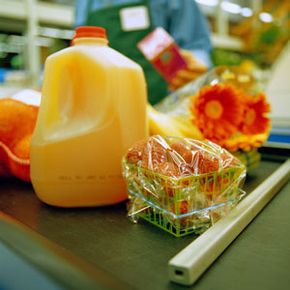In today's consumer-driven world, you can tell a lot about a type of food by the way it's packaged. Regardless if a product is packed into a box, tub, carton, can, jug or bag, its packaging has a lot to accomplish. Packaging needs to keep the food fresh for as long as possible, be easily transportable and, most importantly, attract consumers.
The most obvious and critical duty of food packaging is to keep food fresh. Today's consumers have little patience or desire for questionable-looking food. Spoilage is a huge concern, especially in the meat industry. However, the best packaging options are not always used, and customers' perceived misgivings about food packaging can actually produce more waste and lower-quality food.
Advertisement
Probably Not Coming to a Supermarket Near You
Despite the fact that vacuum-sealed bags, like those that contain hot dogs and bacon, do a better job of keeping meat fresh than plastic wrap, this type of packaging has been slow to catch on with American meat vendors. Most grocery store meat departments cover their beef, chicken and pork with thin, flimsy plastic that oxygen can easily penetrate, causing the meat to spoil quickly. Vacuum-sealing can greatly lengthen meats' expiration date, extending freshness for weeks, compared to mere days guaranteed by plastic wrap. Vacuum-sealed packaging not only allows the product to remain on store shelves longer, it also gives the consumer more time to eat the food at home, generating less waste and more savings for everyone [source: Weaver Street Market].
The only real side effect to using vacuum-sealed bags is the loss of meats' traditional red color. Meat appears red in normal supermarket packages because it has access to oxygen. When that oxygen is taken away, as it is in a vacuum sealed bag, meat takes on a darker tone. Consumers' general ignorance of this fact is the reason this process hasn't caught on in the United States, despite its common use in many other parts of the world [source: Weaver Street Market].
Environmentally Minded Packaging
Many companies are using consumers' growing concern about the environment to sell their products. Fisher, a nut company headquartered in Illinois, is just one company that's recently altered its packaging to reflect higher standards of sustainability. Between 35 and 50 percent of the packaging of many Fisher products now comes from plant-based renewable resources [source: Fisher]. This information is prominently displayed on Fisher's products, as the company clearly wants consumers to know they're making an Earth-friendly choice.
Plastic is Not the New Green
On the other hand, bottled water, a product that's long been marketed as environmentally pure, is considered by many to be the most wasteful product on the market today. More than 38 million disposable plastic water bottles are discarded every year, and many critics point out that bottled water is no different from filtered tap water [source: Howard]. In an effort to mitigate the damage made from such claims, most bottled water packaging assures would-be consumers of the refreshing nature of the product inside.
Advertisement

